Peek into the ancient world of the Nabataeans, their biblical ties, and how they shaped history, leaving more to discover beyond the ruins.
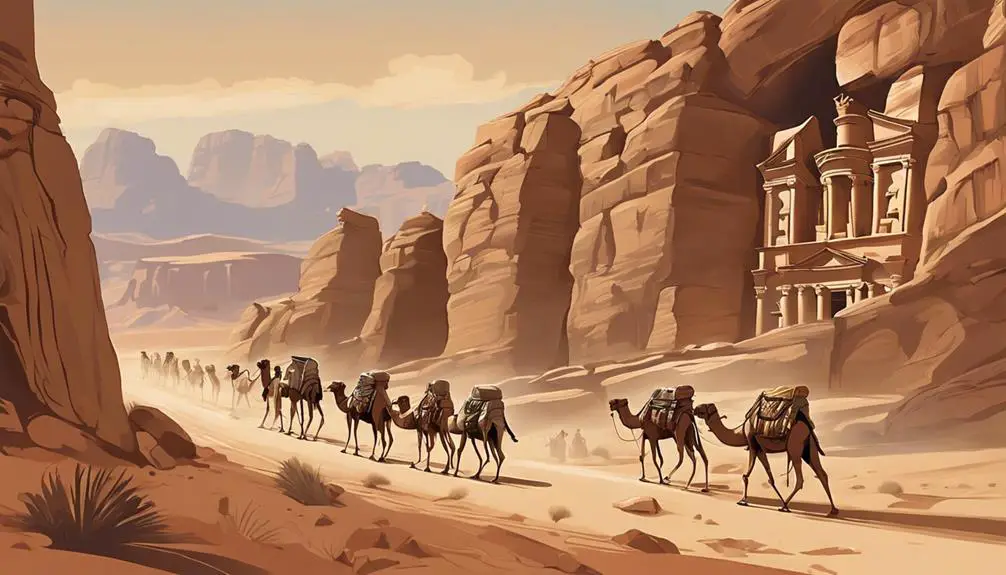
Nabataeans in the Bible
Imagine stumbling upon the ancient city of Petra, marveling at the intricate architecture and wondering about the people who built it. You've heard of the Nabataeans, but did you know they're also mentioned in the Bible? This connection offers a fascinating glimpse into the past, intertwining biblical history with archaeological discoveries.
As you explore the origins of the Nabataeans, their economic prowess, and their interactions with Israel and Judah, you'll uncover how their cultural and religious influences left an indelible mark on the region. But to fully appreciate their role in biblical history, you'll need to look beyond the surface.
Why not join the journey into the past?
Key Takeaways
- Biblical texts reference Nabataeans in trade and military contexts with Israel and Judah.
- Passages in Isaiah, Jeremiah, Ezekiel, 2 Chronicles, and Psalms mention Nabataeans.
- Nabataeans balanced competition and collaboration in territorial and trade disputes.
- Their involvement highlights the interconnectedness of ancient economies and politics.
Origins of the Nabataeans

The Nabataeans, an ancient Arab people, emerged as a distinct group during the 4th century BCE, strategically establishing their kingdom in the rocky, arid regions of what's now southern Jordan and northern Arabia. Initially, they were desert nomads, adept at surviving and thriving in harsh desert environments. This nomadic lifestyle, characterized by seasonal migrations and a deep understanding of desert geography, played a crucial role in the formation of their society and economy. Archaeological evidence, including inscriptions, pottery, and monumental architecture, sheds light on their transition from nomadic life to establishing a powerful trading empire.
Archaeological findings provide a window into the origins of the Nabataeans. These discoveries reveal a sophisticated society that mastered the art of desert living, developed innovative water collection techniques, and engaged in long-distance trade. Their strategic location enabled them to control trade routes, connecting the East and West, facilitating the exchange of goods, ideas, and cultural practices. The evidence points to a gradual shift from a nomadic to a sedentary lifestyle, laying the foundation for the rise of the Nabataean kingdom. This transition underscores their adaptability and resourcefulness, hallmarks of Nabataean civilization.
Biblical References Explained
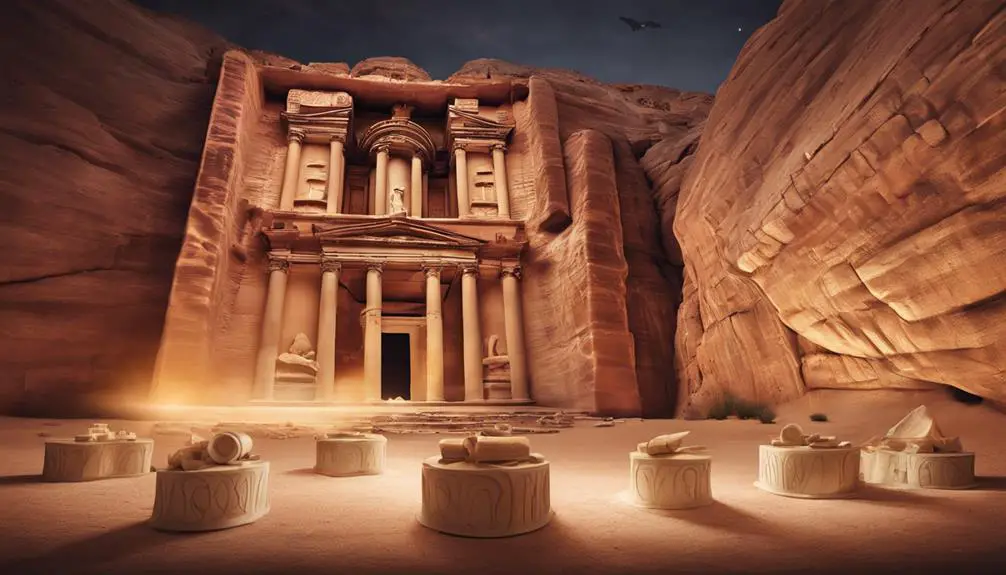
How do biblical texts reference the Nabataeans, and what insights do these passages offer into their history and interactions with neighboring cultures? The biblical narratives provide a layered understanding, enhanced by archaeological evidence, of the Nabataeans' pivotal role in the ancient Near East. These references, often encapsulated in prophecies, not only narrate historical episodes but also underline the fulfillment of prophecy, illustrating the interconnectedness of cultures and divine oversight in historical processes.
Passage |
Emotion Evoked |
Insight Offered |
|---|---|---|
Isaiah 21:13 |
Awe |
Prophecy against Arabia, hinting at the Nabataeans' desert dwellings and their eventual prominence. |
Jeremiah 49:28-33 |
Foreboding |
Predictions of doom for Kedar and Hazor, areas associated with Nabataean influence, showcasing the transient nature of power. |
Ezekiel 27:21 |
Nostalgia |
Mention of Arab merchants, likely Nabataeans, in Tyre's markets, highlighting their trade importance. |
2 Chronicles 9:14 |
Curiosity |
Reference to Arabian gifts to Solomon, possibly indicating early Nabataean interactions with Israel. |
Psalms 120:5 |
Melancholy |
A lament of dwelling among Meshech and Kedar, evoking the challenges of coexistence with the Nabataeans. |
These passages, analyzed alongside archaeological evidence, deepen our understanding of the Nabataeans, their societal structures, and their fulfillment of biblical prophecies.
Trade Routes and Economic Power
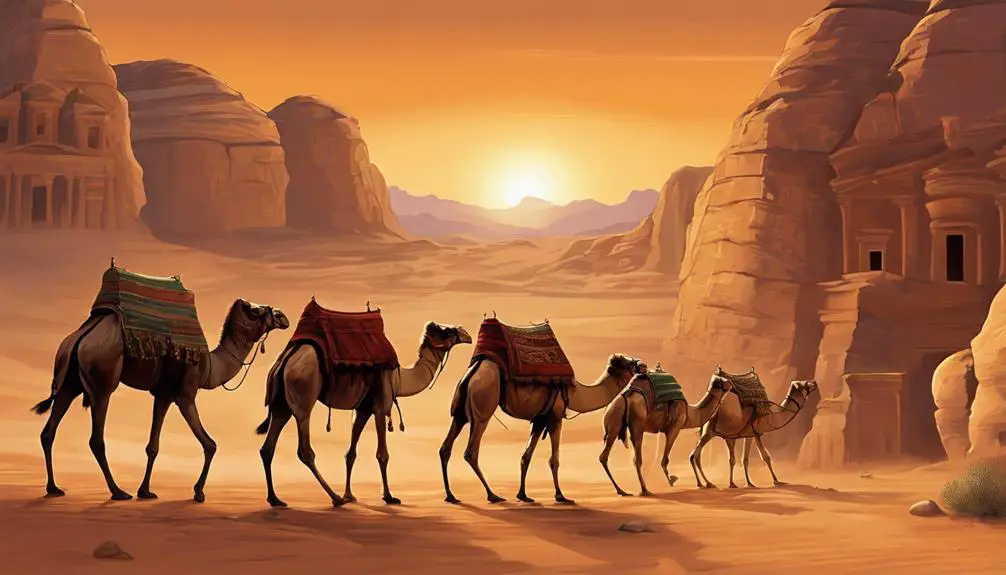
Understanding biblical references to the Nabataeans enriches our grasp of their historical significance, particularly when examining their establishment of lucrative trade routes and economic dominance in the ancient Near East. The Nabataeans' mastery over desert navigation and caravan management played a pivotal role in their ascent as a commercial power. They transformed inhospitable deserts into conduits of wealth and information, connecting the Mediterranean world with the Arabian Peninsula and beyond.
Their strategic control over these trade routes allowed them to monopolize the incense and spice trade, essential commodities in ancient cultures for religious and culinary purposes. This monopoly didn't come by chance; it was the result of sophisticated understanding of desert geography and innovative water conservation techniques, which enabled them to sustain not only their caravans but also their cities along these trade paths.
The economic power they wielded due to their trade networks afforded them influence that extended beyond mere commerce. It facilitated cultural exchanges and contributed to their political leverage in the region. Thus, the Nabataeans' economic prowess, rooted in expert desert navigation and caravan management, was instrumental in their historical legacy, echoing through biblical narratives and beyond.
Relations With Israel and Judah
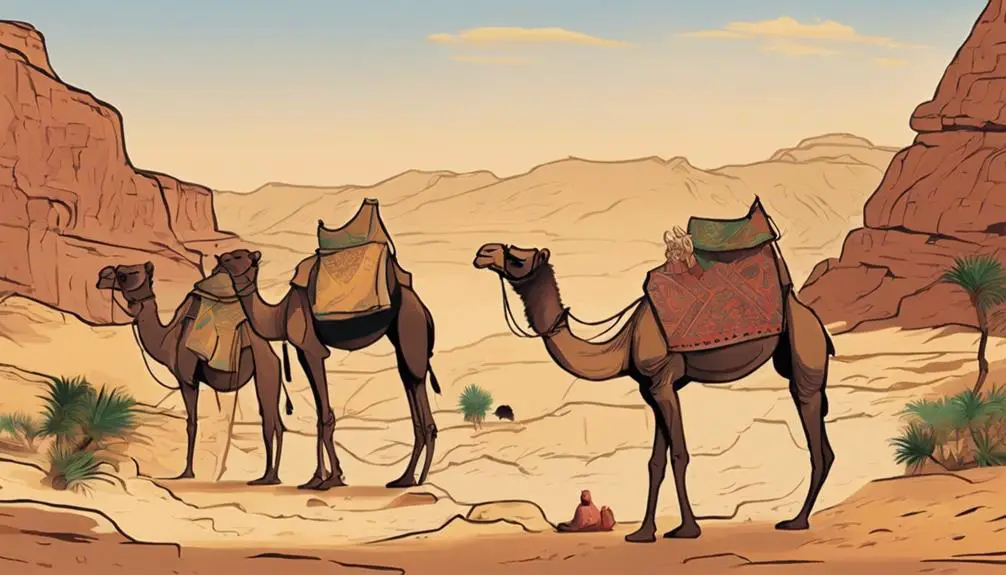
Several accounts in historical and biblical records highlight the complex and multifaceted relations between the Nabataeans and the kingdoms of Israel and Judah, underscoring their significant role in regional politics and trade dynamics. These interactions were marked by a fluctuating landscape of military alliances and territorial conflicts, reflective of the broader geopolitical tensions of the ancient Near East.
You'll find that the Nabataeans, while often engaged in trade with Israel and Judah, didn't shy away from leveraging their military might and strategic geographic positioning to influence the balance of power. Military alliances were formed, sometimes as pragmatic measures to counter common threats, and at other times, as calculated moves to gain territorial advantage or control over lucrative trade routes.
Territorial conflicts between the Nabataeans and these Hebrew kingdoms weren't uncommon, arising from competing interests over land and trade dominance. These skirmishes, while sometimes leading to short-term gains for one party, also paved the way for periods of negotiation and peace treaties, showcasing a dynamic interplay of conflict and cooperation.
In essence, the relationship between the Nabataeans and the kingdoms of Israel and Judah was characterized by a continual balancing act between competition and collaboration, reflecting the intricate nature of ancient Near Eastern diplomacy and interstate relations.
Cultural and Religious Influences
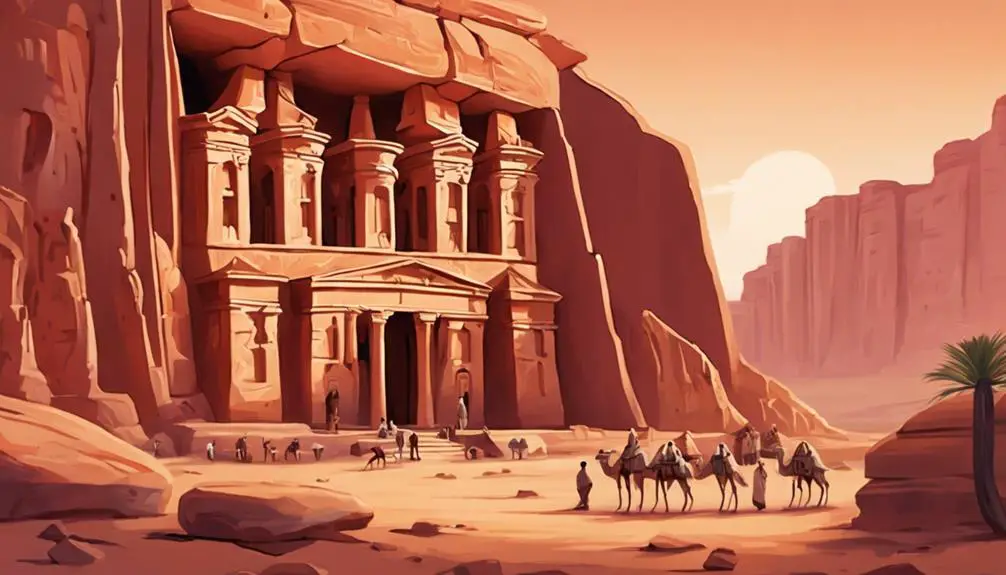
While the Nabataeans engaged in complex political and military interactions with the kingdoms of Israel and Judah, they also left a significant mark on the cultural and religious landscape of the region. Their influence extended beyond mere trade and commerce, seeping into the very fabric of local customs, beliefs, and practices.
You'll observe that Nabataean architectural styles, characterized by their intricate rock-cut facades and innovative water management systems, had a profound impact on the construction techniques and aesthetic preferences in surrounding areas. This architectural prowess not only demonstrated their advanced understanding of engineering and artistry but also mirrored their sophisticated social hierarchy. The grandeur of their monuments and tombs reflected the status and wealth of the elite, while also serving as a testament to their religious beliefs and practices.
Moreover, the Nabataeans' religious practices, which included the worship of a pantheon of deities such as Dushara and Al-'Uzza, introduced new religious concepts and rituals. This syncretism, where Nabataean deities were identified with or worshipped alongside local gods, facilitated a cultural exchange that enriched the spiritual tapestry of the region, demonstrating the interconnectedness of political, social, and religious spheres.
Frequently Asked Questions
How Did the Nabataeans' Architectural Achievements, Such as Petra, Influence Later Civilizations or Cultures?
The Nabataeans' architectural feats, notably Petra, significantly impacted subsequent civilizations. Their designs, infused with Greek influence, showcased advanced engineering and artistry.
Following the Roman conquest, these achievements were further disseminated, blending Nabataean innovations with Roman architectural principles. This fusion not only enriched the Roman Empire's architectural landscape but also left a lasting legacy on Islamic architecture, illustrating a profound cultural and technological exchange that shaped the development of subsequent architectural practices.
In What Ways Did Nabataean Language and Script Contribute to the Development of Arabic Script and Language?
You're exploring how Nabataean language and script spurred the development of Arabic script and language. Their script's evolution is a key point, showing a direct lineage to Arabic.
This linguistic influence is significant, as Nabataean script bridged ancient scripts to early Arabic forms. Their contributions are crucial for understanding the script's evolution, demonstrating how the Nabataeans played a foundational role in shaping the Arabic language and its script's historical progression.
Are There Any Specific Nabataean Artifacts or Archaeological Discoveries That Have Significantly Altered Our Understanding of Their Society or Relationships With Neighboring Peoples?
Yes, specific Nabataean artifacts, like their intricately designed pottery and evidence of their religious practices, have greatly changed our understanding of their society and interactions with neighboring groups.
The pottery reveals insights into their daily life and trade, while artifacts related to worship provide clues about their beliefs and how these influenced or were influenced by neighboring cultures.
These discoveries have deepened our comprehension of their societal structures and external relations.
How Did the Nabataeans Manage Water in Their Arid Environment, and What Innovations Did They Introduce That Might Be Considered Advanced for Their Time?
You'd be amazed at how the Nabataeans mastered water management in their dry landscape. They innovated water harvesting techniques, collecting rainwater in cisterns and dams, a practice far ahead of their time.
Additionally, they practiced terrace farming, cleverly preventing soil erosion and maximizing agricultural output. These advancements not only showcase their ingenuity but also highlight their deep understanding of the environment, making them pioneers in sustainable living.
Can the Decline of the Nabataean Kingdom Be Attributed to Environmental Changes or Shifts in Trade Routes, and What Evidence Supports This?
You're examining whether the Nabataean kingdom's decline stemmed from environmental shifts or changes in trade routes. There's evidence pointing towards both factors, alongside the impact of Roman annexation and religious transformation.
Scholars argue that trade route diversification, especially with the Romans controlling major ports, significantly undercut the Nabataeans' economic base. Additionally, environmental changes may have exacerbated these challenges, although the precise role remains debated within academic circles.
Conclusion
In conclusion, you've explored the intricate connections between the Nabataeans and biblical narratives, highlighting their origins, economic prowess, and interactions with Israel and Judah. Analyzing these aspects reveals the Nabataeans' significant impact on trade, culture, and religion in the ancient Near East.
Their strategic trade routes and relationships with neighboring states underscore their role in regional dynamics. Understanding these interactions enhances our comprehension of the complex socio-political and religious landscape during biblical times.



Sign up